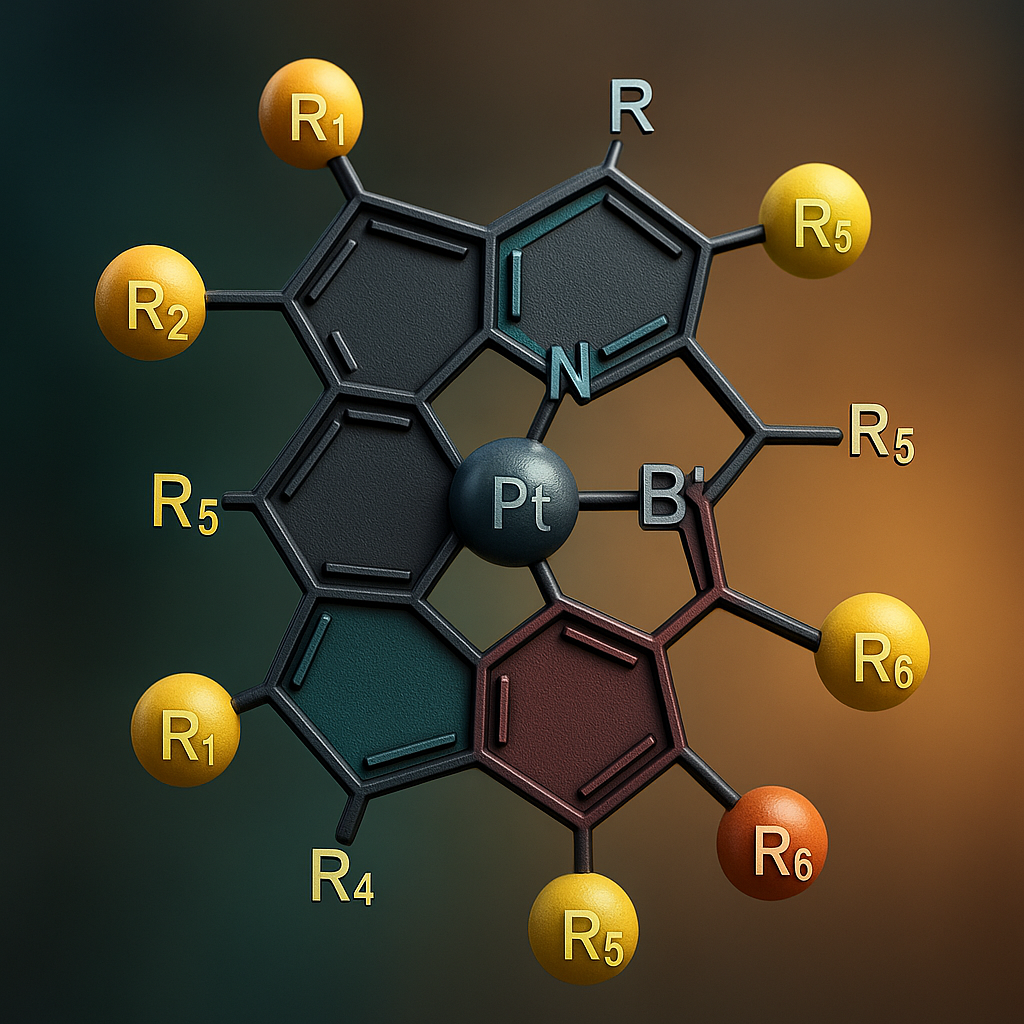ORGANIC ELECTROLUMINESCENT MATERIALS AND DEVICES

Invented by Ji; Zhiqiang, Lu; Tongxiang, Wozniak; Derek Ian, Boudreault; Pierre-Luc T., Dyatkin; Alexey Borisovich, Sheina; Elena, Universal Display Corporation

Understanding new technology in the world of light can be tough. But when it comes to making the screens on our phones, TVs, and lights better, every small change matters. Right now, organic light emitting diodes (OLEDs) are everywhere. They make screens brighter, clearer, and more colorful. Now, a new patent application is trying to make OLEDs even better by introducing a special kind of chemical compound.
Let’s break down what this invention is all about, why it matters, and how it could change the way we see the world on our screens.
Background and Market Context
The world wants brighter, thinner, and more flexible electronic displays. OLEDs are already a big step in that direction. They use organic compounds that light up when electricity runs through them. This makes them different from older screens that need backlights and filters. Instead, OLEDs can be very thin, bendable, and show deep colors.
Companies making TVs, phones, watches, and even car dashboards want the best possible screens. The market for OLED displays is huge and growing fast. People want their screens to look great from every angle and work in all kinds of light. They want bright reds, blues, and greens, as well as true blacks. They want screens that are easy on the eyes, use less energy, and last longer.
But making OLEDs is hard. The chemicals inside them have to be just right. They need to shine bright, use little power, and not wear out too fast. The red color, in particular, has been a challenge. Getting a strong, pure red that lasts a long time has been tricky. Chemicals that work for blue or green don’t always work for red because of how light works at different wavelengths.
This is where the new patent comes in. The inventors have made a new family of compounds that are designed to work as the “emissive” part of OLEDs—that is, the part that actually glows. These new materials aim to make OLEDs brighter, more efficient, and more stable. If they work as hoped, they could make future screens look better and last longer, all while using less energy.

The invention is not just about making better TVs or phones. It could help with lighting too—think of smart bulbs or car lights that use OLEDs. It could make flexible displays more reliable, help with rollable or foldable screens, and even create completely new kinds of products that we haven’t seen yet.
Scientific Rationale and Prior Art
To see why these new compounds matter, it helps to know how OLEDs work and what has been tried before.
An OLED is built from layers of materials. The most important layer is the one that lights up—the emissive layer. When electricity moves through the OLED, it creates “excitons”—pairs of electrons and holes that want to join together. When they do, they release energy as light.
The color of that light depends on the chemical structure of the emissive molecule. For red, the molecule needs to release just the right amount of energy. If it releases too much, you get blue or green. Too little, and you get infrared (which we can’t see).
In the past, scientists used organic molecules based on hydrocarbons (just carbon and hydrogen) or simple heterocycles (rings with nitrogen, oxygen, or sulfur). These can emit light, but they’re not very efficient. Most of the energy is lost as heat, and only about a quarter of the excitons make light. The rest just fade away.
To fix this, researchers started adding metals to the molecules. Metals like iridium (Ir) or platinum (Pt) can help “harvest” all the excitons, not just some. This means much more of the electric energy turns into light—a huge efficiency boost. These are called organometallic complexes.

But even metal-based OLEDs have problems. The ligands (the parts of the molecule attached to the metal) have to be just right. If they’re not, the color won’t be pure, or the material won’t last long. The metal can change the color or cause the molecule to break down. For red emission, it’s especially tricky to get a pure color that’s also bright and stable.
Many patents have focused on adjusting the ligands—adding rings, swapping out atoms, or fusing rings together. Fused rings (where two or more rings share atoms) can make the molecule more rigid, which often means better color and longer life. Adding atoms like nitrogen (N) or boron (B) can change how electrons move, fine-tuning the color and efficiency.
Past inventions have tried all sorts of ring systems: phenylpyridine, carbazole, imidazole, and more. Some have used deuterium (a form of hydrogen) to make the molecules more stable. Others have used electron-withdrawing or electron-donating groups to change the color or efficiency.
Yet, even with all these changes, there’s still room for improvement. Red OLEDs still lag behind blue and green in efficiency and lifetime. The field is always looking for new ligands and new ways to assemble them around metals to make better OLEDs.
The new patent builds on all this, but introduces a new set of ligands with unique fused rings and special atoms. The idea is to combine the best of past work—rigid, stable ligands, smart use of metals, and clever atom choices—to get the perfect mix of color, brightness, and durability.
Invention Description and Key Innovations
Now let’s get into what this patent is actually claiming—and why it could be a game changer for OLEDs.

The heart of the invention is a family of new organometallic compounds. These compounds have a central metal atom (like Ir, Pt, or Pd) surrounded by a special ligand called LA. This ligand is built from a unique fused ring system, which means several rings are joined together, sharing atoms.
The central ring (called ring P) is made from six atoms. These atoms can be carbon (C), nitrogen (N), or boron (B). At least one atom must be N or B, which helps tune the electronic properties. Around this ring, at least four pairs of “substituents” are joined to make fused rings. This makes the whole structure large, flat, and very rigid.
The substituents (labeled R1 through R6) can be almost any group—hydrogen, alkyl, aryl, halogen, amino, and many more. Some can even be joined together to make even bigger rings. This flexibility lets chemists fine-tune the properties.
This central ligand wraps around a metal atom, forming a stable complex. The metal can be iridium, platinum, palladium, and others. The way the ligand and metal are connected (called chelation) can be either a 5-membered or 6-membered ring, which also affects stability and color.
The patent claims a huge range of possible compounds by varying the ring atoms, the fused rings, and the substituents. Some versions use two or more ligands joined together, making tridentate, tetradentate, or even bigger “multidentate” complexes. This can make the complex even more stable.
One of the key innovations is the use of at least four fused rings around the central ring. This rigid framework helps the compound keep its shape and not break down when hit by light or heat. It also helps produce very pure colors—important for display applications.
Another innovation is the flexibility in atom choice. By mixing carbon, nitrogen, and boron, the inventors can tune the electronic structure to get exactly the red color they want, while keeping efficiency high and lifetime long.
The patent also covers how these compounds can be used. They’re not just for making OLEDs that glow red—they can be used for green or blue, too, by tweaking the structure. They can be used as the main emitter, as a sensitizer (helping other materials glow), or as part of the charge transport system.
The inventors even describe how to make the compounds, step by step. They start with simple building blocks, add rings, swap atoms, and finally add the metal. The process uses standard chemistry methods but applies them in new ways to build these unique fused-ring ligands.
Real-world testing shows that these compounds can have very high quantum yields (which means most of the energy put in comes out as light), short excited-state lifetimes (which helps avoid problems like “quenching” that can dim the light), and strong, pure red emission. In one example, a compound made using this approach glowed red at 635 nm, had a quantum yield of 81%, and a short lifetime of 2.0 microseconds—all excellent results for an OLED emitter.
The patent also covers how these compounds can be used in devices. You can put them in the emissive layer of an OLED, add them to a mix of host materials, and build up all the layers needed for a working display or light source. The compounds work well with all the modern methods of making OLEDs, from thermal evaporation to inkjet printing.
Finally, the inventors note that these compounds aren’t just for screens—they could be used in lighting, sensors, or even solar cells. The basic chemistry is flexible enough to be used in many different devices.
Conclusion
This new patent represents a big step forward in the science of OLEDs. By creating a new family of organometallic compounds with special fused rings and clever atom choices, the inventors have found a way to make OLED emitters that are bright, efficient, and stable—especially in the hard-to-master red part of the spectrum. Their approach builds on years of research and combines the best ideas into a flexible new platform.
If these compounds live up to their promise, they could help make future OLED screens brighter, longer-lasting, and more colorful. That means better TVs, phones, watches, and lights for everyone. This invention shows how deep chemistry and smart design can change the way we see the world—one pixel at a time.
Click here https://ppubs.uspto.gov/pubwebapp/ and search 20250221296.


